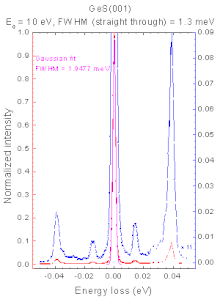High resolution electron energy loss spectroscopy
The high-resolution electron energy loss spectroscopy , and high-resolution electron energy loss spectroscopy ( English High-Resolution Electron Energy Loss Spectroscopy , HREELS) is an analytical method of surface physics. The measurement method is based on the inelastic scattering of electrons on a surface in order to characterize electronic excitations or vibration modes of the surface or of adsorbates (such as atoms or molecules) on it. In contrast to other electron energy loss spectroscopy (EELS), small energy losses in the range from 1 meV to 1 eV are analyzed, which corresponds to the energy of light in the infrared range . The resulting spectra are similar to those of other spectroscopies in the same energy range, such as infrared or Raman spectroscopy .
functionality
In electron energy loss spectroscopy, an electron beam of defined energy is shot at a sample surface, usually a solid body (primary electron beam). These electrons interact with the sample and, depending on their primary energy, experience characteristic energy losses due to inelastic scattering on the surface. The scattered electrons are then analyzed energetically. The intensity of the individual energy losses is recorded with the aid of the analyzer and a spectrum is created from this (see graphic). In order to meet the requirements for a high energy resolution, a special structure is necessary. The most common structure here is that of Harald Ibach et al. was developed. This consists of a double monochromator and an analyzer. Since magnetic fields are difficult to shield and residual magnetic fields, especially in the scattering chamber of the spectrometer, greatly reduce the energy resolution, only electrostatic methods are used for all energy-dispersive parts of the spectrometer. The monochromators and the analyzer are similar to those of a hemisphere analyzer . However, since significantly higher electron currents have to be achieved, only 127 ° designs are used instead of the 180 ° designs of hemisphere analyzers. After the electrons have passed through the analyzer, they are detected using a channeltron .
In high-resolution electron energy loss spectroscopy, the energy of the primary electrons is usually below 10 eV. In addition, a special high-resolution spectrometer is used to detect even very small differences in the spectrum of the secondary electron beam.
application
Among other things, HREELS is used in the investigation of surfaces (for example in the analysis of thin layers ) and surface reactions (such as catalytic reactions ). Furthermore, the binding relationships of adsorbates (atoms and molecules) on solid surfaces can be clarified.
literature
- Michael A. Chesters: High-resolution Electron Energy Loss Spectroscopy . In: John M. Chalmers, Peter R. Griffiths (Eds.): Handbook of Vibrational Spectroscopy . John Wiley & Sons, Chichester et al. 2001, ISBN 0-471-98847-2 .
- H. Ibach, DL Mills: Electron Energy Loss Spectroscopy and Surface Vibrations . Academic Press, New York NY et al. 1982, ISBN 0-12-369350-0 .
- Bruce E. Koel: High-Resolution Electron Energy Loss Spectroscopy . In: C. Richard Brundle, Charles A. Evans, Shaun Wilson (Eds.): Encyclopedia of materials characterization. Surfaces, interfaces, thin films (= Materials Characterization Series ). Butterworth-Heinemann et al., Boston MA a. a. 1992, ISBN 0-7506-9168-9 , pp. 442-458 .
